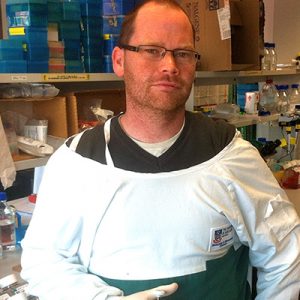
MS is thought to result from immune cells such as white blood cells entering the central nervous system (CNS, the brain and spinal cord) and attacking the myelin. The entry of these immune cells into the CNS is controlled by molecules known as chemokines. This project will use laboratory models of MS and human stem cells to investigate the effect of influencing the function two regulators of chemokines, known as D6 and CCX-CKR, within the brain. It is thought that the presence of these chemicals may help to limit antibody entry into the brain and help prevent neuroinflammation.
Dr Comerford will also modify human stem cells to boost their capacity to enter the CNS, with two aims. Firstly, the researchers aim to test whether stem cells could be used to deliver the D6 and CCX-CKR chemicals into the CNS to inhibit the MS inflammatory response. Secondly, they aim to explore whether the stem cells themselves could induce any anti-inflammatory or regenerative effects on the nerve cells. Therefore, this project has direct potential to lead to the development of novel therapies for people with MS, and will increase our understanding of regulation mechanisms of antibodies and stem cells.
The project grant was founded on novel data that showed expression of chemicals in immune T cells was associated with profound inhibition of the onset of illness in MS-like mice, and also reduced inflammatory activity. This important work will further our understanding of the inflammation processes within the brain in MS and to identify potential targets for future therapies to target.
Initial analyses aimed to assess the effects of inducing D6 or CCX-CKR in the brain, and whether this had any effects on disease onset or severity of MS-like illness in mice. Early attempts to create these transgenic mice have not shown significant differences in MS-like symptoms between D6 mice and control mice, however, the two groups of mice showed differences in overall physical size, and so it is difficult to draw firm conclusions. Further analyses are ongoing to test alternative methods for assessing the effects of chemokine regulators D6 or CCX-CKR in the brain and spinal cord of MS-like mice.
The second aim of this project is to determine the effects of expression the D6 and CCX-CKR chemicals within two different types of human stem cells, and to assess whether these cells could be transplanted into mice with MS-like illness. Preliminary experiments have introduced these cells into mice and have successfully delayed and reduced disease. These results will now be extended to determine the mechanism underpinning these results.
Dr Comerford has also done some additional work to create a method for testing the movement of stem cells into the brain and spinal cord and now has two robust systems for testing this in the laboratory. Using these new assays in some preliminary experiments, Dr Comerford has shown that the movement of the stem cells into the brain and spinal cord can be improved by modulating the expression of chemokine receptors CCR2 and CCR7 in mice with MS-like disease. Further studies are ongoing to determine the precise actions of the stem cells over time.
Updated: 8 October 2015
Updated: 06 January, 2013

